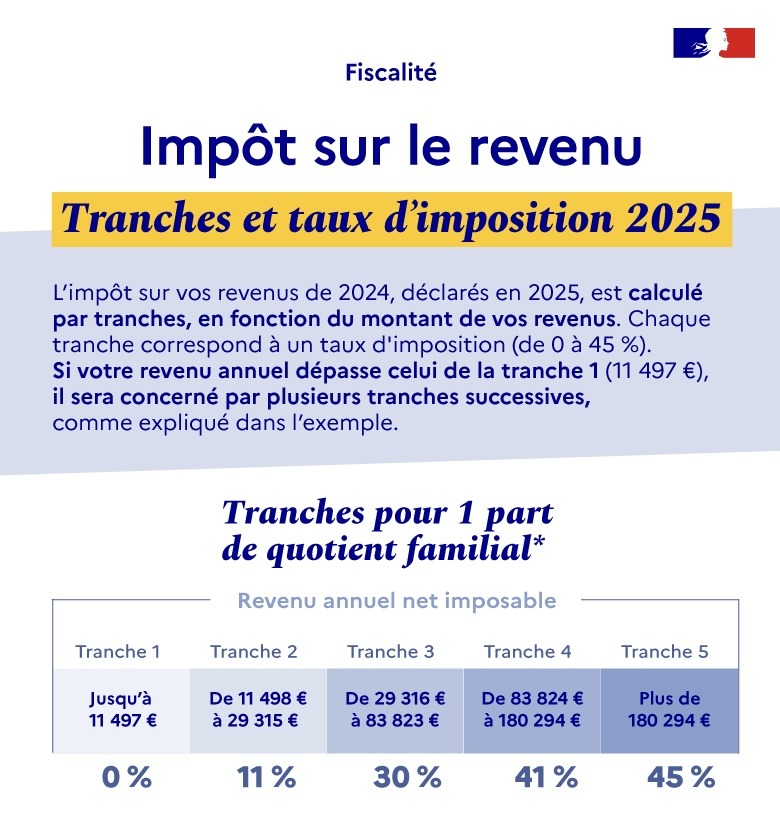Updated on: February 15, 2025 | By: @rprasanth_kumar
The French income tax brackets and tax rates are fixed every year. For example, the 2025 values (applicable to income earned in 2024) are defined by the 2025 finance law Budget in France: Projet de loi de finances – PLF 2025“.
Accounting for inflation, the 2025 income tax brackets were increased by 1.8%, when compared with 2024 values.
- If your income hasn’t increased by at least 1.8%, your income tax will automatically decrease.
- On the other hand, if your salary increased by this amount, your taxes will be about the same as in 2024.
Income Tax Rates – Barème de l’impôt 2025
The following table explains the income tax brackets tranches d’imposition and tax rates taux d’imposition applied to your income earned from January to December 2024.
The income mentioned in the below table is after removing the 10% standard deduction or the actual professional expenses “frais réels“. To know more about these deductions, Impôt sur le revenu – Frais professionnels: forfait ou frais réels (déduction)
| 2025 Income Tax Brackets | Tax Rates |
| €0 to €11,497 | 0 % |
| €11,498 to €29,315 | 11 % |
| €29,316 to €83,823 | 30 % |
| €83,824 to €180,294 | 41 % |
| Above €180,294 | 45 % |

Family Quotient “Quotient Familial”
According to Article 193 of the General Tax Code (CGI), the family quotient is a system that divides the total taxable income into several shares or parts of the family. Based on the taxpayer’s personal and family circumstances and the number of dependents, the family quotient is used to define the income that serves as the benchmark for determining the amount of income tax.
Some examples:
- If you are single, divorced, or widowed, without dependent children, you will have only 1 part of the family quotient.
- If you are married or PACSed, without dependent children, you will have 2 parts of the family quotient.
- If you have dependent children, you can benefit from additional family quotient parts.
- If you are disabled or a veteran, you can also benefit from additional family quotient parts (Article 195).
Attention: The Quotient Familial used by the tax office is different from the one used by CAF. For more information, Quotient familial : Caf, impôts, quelles différences ?
Number of children under your charge | Number parts by Family Quotient | |
| Single or Divorced | Married or PACSed Couple | |
| 0 | 1 | 2 |
| 1 | 1.5 | 2.5 |
| 2 | 2 | 3 |
| 3 | 3 | 4 |
| 4 | 4 | 5 |
| per additional child | +1 | +1 |
How to calculate your income tax?
The income tax is calculated from our net taxable income “revenu net imposable (RNI)“, in 3 major steps.
- Divide the net taxable income (RNI) by the number of family members “quotient familial“.
- Then apply this value to the income tax brackets and income tax rates from the above table.
- Multiply the result by the number of parts in the quotient familial” to obtain the amount of tax. This is the Gross Tax Impôt Brut (IB) to be paid by the household.
Note: The Net Tax Impôt Net (IN) to be paid can be obtained by subtracting the various tax credits and reductions from the Gross Tax.
Here are a few example calculations of Income tax in France, based on the number of taxable people in the family.
Example 1: Single person with net taxable income of €32,000 in 2024
Step 1: If you are a single, unmarried, divorced, or widowed person without children, the number of parts in your family quotient is 1.
- So, 32,000 € / 1 = 32,000 €.
Step 2: Then apply this value to the income tax brackets and tax rates of 2025, applicable to the income earned during 2024.
| Income Tax Brackets (for one family member) | Tax Rates | Tax to be paid |
| €0 to €11,497 | 0 % | 0€ |
| €11,498 to €29,315 | 11 % | (29,315 – 11,497) x 11 % = €1959.98 |
| €29,316 to €32,000 | 30 % | (32,000 – 29,315) x 30% = €805.50 |
| Total | 1959.98 + 805.50 = €2,765.48 | |
So, you fall in the 30% tax bracket taux marginal d’imposition (TMI), but not all your income is taxed at 30%. This is explained in the above table.
Step 3: To find the tax that you have to pay on your income, you should again multiply this value by the number of parts “family quotient”.
- €2,765.48 x 1 = €2,765.48. This is the Gross Tax Impôt Brut (IB) to be paid by the household.
Example 2: A married or PACSed couple with 2 minor children and a net taxable income of €60,000 in 2024
Step 1: If you are a couple with 2 minor children, the number of parts in your family quotient is 3. It is two parts for the couple and half a part for each child.
- So, €60,000 / 3 = €20,000.
Step 2: Then apply this value to the income tax brackets & tax rates of 2024, applicable on the income earned during 2023.
| Income Tax Brackets (for one family member) | Tax Rates | Tax to be paid |
| €0 to €11,497 | 0 % | 0€ |
| €11,498 to €20,000 | 11 % | (20,000 – 11,497) x 11 % = €935.33 |
| Total | €935.33 | |
So, you fall in the 11% tax bracket taux marginal d’imposition (TMI), but not all your income is taxed at 11%. This is explained in the above table.
Step 3: To find the tax that you have to pay on your income, you should again multiply this value by the number of parts “family quotient”.
- So, €935.33 x 3 = €2,805.99. This is the Gross Tax Impôt Brut (IB) to be paid by the household.
- However, the couple’s income tax amount is below the threshold of €3,248 so eligible for a tax reduction.
- The reduction is calculated as follows: €1,470 – (€2,805.99 x 45.25%) = €1,470 – €1,269.71 = €200.29, which rounds up to €200.
- The final tax amount after applying the reduction (décote) is: €2,805.99 – €200 = €2,605.99
Income Tax Calculator in France
You can now use the official 2025 income tax calculator for 2024 income to estimate your tax amount and reference tax income (revenu fiscal de référence). It accounts for the updated income brackets with different tax rates in 2025.
The simulator is useful only for residents of France and has two versions:
- Simplified model: For those reporting only salaries or pensions and common deductions (child support, childcare costs, donations, etc.).*
- Complete model: For those with additional income sources (business, freelance, agriculture, overseas investments, deficits, etc.).
Sources & References
- Impôt sur le revenu: tranches et taux d’imposition 2025 Service-public.fr
- Calculation of income tax Code général des impôts : articles 193 à 199
- Bofip-Impôts n°BOI-IR-LIQ-20 relatif au calcul de l’impôt sur le revenu
DISCLAIMER
Any finance-related information shared is not professional legal, tax, or investment advice. The information provided is of an educational and general nature and is not investment advice within the meaning of Articles L. 321-1 and D. 321-1 of the French Monetary and Financial Code. Investment carries risks of loss and past performance does not guarantee future performance. Please consult a financial advisor for any professional advice.




Question from reader:
Good morning Everyone, I have a small question, when taxes are deducted monthly from a couple, who is calculating the tax,
1. Each employer is calculating the taxes – in this case, how do they know the salary of their respective partner
2. The income tax department tells the respective employers the situation of each couple and they calculate it and then it is deducted? – it is less likely possible from my understanding of the Indian system, where tax declarations exist between employers and employees.
3. The couple taxes are considered at the end of the year?
Context: I am new in France and would like to understand the declarations for a couple.
Thanks
My answer: Single or married couple, 1 tax declaration is submitted per household.
– Case 1: A single person without children submits a tax declaration for 1 person (1 income). The employer applies the TDS % on monthly salary, based on this declaration. Impots communicates this % to employer.
– Case 2: It’s almost the same for a working couple. They are 2 ppl & so 2 incomes are declared jointly. Impots calculates the TDS % for each person & communicates the same to respective employers. By default, a common TDS % rate (taux foyer or taux commun) is applied to the couple but they can choose to have individual rates, especially when there is a huge difference between their salaries.
– From 1st Sept 2025, individualized TDS % (taux individualisé) will be the default automatic option.
– In both cases, people can modify their TDS % online at any time of the year. Use the option “ Gérer mon prélèvement à la source” after logging into your Impots account.
Note: If someone is new to France & hasn’t done a tax declaration, then employers will either apply 0% TDS (big lump sum tax bill following year) or an approximate TDS %. The difference will be regulated when the annual income tax declarations are processed.
TDS: Tax Deducted at Source. Also, known as withholding tax. In French, it is Prélèvement à la source (PAS).
Hi Prasanth,
My partner will file tax returns for the first time this year( so paper based). He moved here last year and doesn’t have a TIN yet.
Without his TIN, can I file mine as couple? (with family quotient as 2)